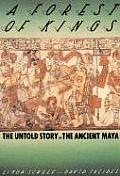Published in 1990, Schele and Freidel’s book draws on then-recent archeological and linguistic discoveries to paint a new portrait of the Mayan civilisation. While both emphasise that their work draws on past work and more recent collaborative efforts with others, their own experience and expertise adds authoritative weight to this book.
Then an art teacher, Schele first encountered the Mayan ruins as a tourist in 1970. Inspired by what she found there, she spent the next decades working with others to decipher the hieroglyphics on the remaining monuments. She says in the Prologue, “I had the understand how, why, when, and who had made these things.” The book is lavishly illustrated with photographs and drawings of the art, often with direct translations of the hieroglyphics.
Freidel brings an archeologist’s viewpoint. His first visit to the area was in 1971. He says, “I wanted to know what the relationship was between political power and religious belief among the ancient Maya.” This sociological approach, combined with the evidence derived from the translations, gives us factual descriptions interspersed with vignettes that enable us to participate in the daily life of these ancient peoples.
The Mayan civilisation lasted for thousands of years, starting from around 2,000 BC until the Spanish conquest in 1,697 CE. The account in this book takes us through the various phases of this civilisation, which was located in the Yucatan peninsula. The authors are careful to identify when they are speculating (and on what evidence) and when they are working from reliable information drawn both from the record left behind by the Mayans and from accounts left by other Mesoamerican peoples and the Spanish themselves.
Of course, there are still Mayan descendants, despite efforts by the Spanish to destroy their language and history and their subjugation by later groups. One of the most touching moments in the book comes when Schele gave a workshop to forty Maya men and women, helping them learn how to translate their own historical texts for the first time.
What I, as a reader and writer, loved most in this book was the extent to which the civilisation was built on literacy. I had not realised that these stone monuments were actually historical texts, nor how sophisticated the language, imagery, and ritual were.
When literacy began to fail, the civilisation faltered. While the near-simultaneous collapse of the Classic Mayan Civilisation in the 9th century CE continues to be an intriguing mystery, the authors are able to identify some factors. After that point, no more engravings were created. Literacy was “abandoned” along with the belief in their kings that had been their guiding philosophy. The authors see a strong correlation between the collapse and the failure of “historical kingship”, the long dynasties of kings memorialised in the monuments we see today.
One factor that resonated with me was income inequality. As the kingdoms prospered, a wealthy elite grew up who not only challenged the king’s power but hogged resources. In some kingdoms, where population growth exceeded the agricultural capacity, income inequality exacerbated the problem, with the elite building palaces on arable land and, based on physical evidence, having plenty to eat while everyone else starved.
Another factor that resonated was the endless warfare, with each kingdom trying to grab more territory. Proving himself a powerful warrior was essential to a king’s power.
After the collapse, a few small kingdoms rose in the southern regions who tried to claim kinship with the great kings of the past, as well as communities that “eschewed royal history”. In the north, there emerged “a cyclic form of government in which power became centralized at one regional capital, then dissolved to re-form elsewhere.” Small states continued to bicker amongst themselves until the Spanish arrived.
The lengthy footnotes, maps, glossary and bibliography testify to the amount of research that went into creating this clear and readable account of a vanished civilisation. This book is a great introduction to that world.
Have you ever visited the Mayan ruins or been curious about their civilisation?

